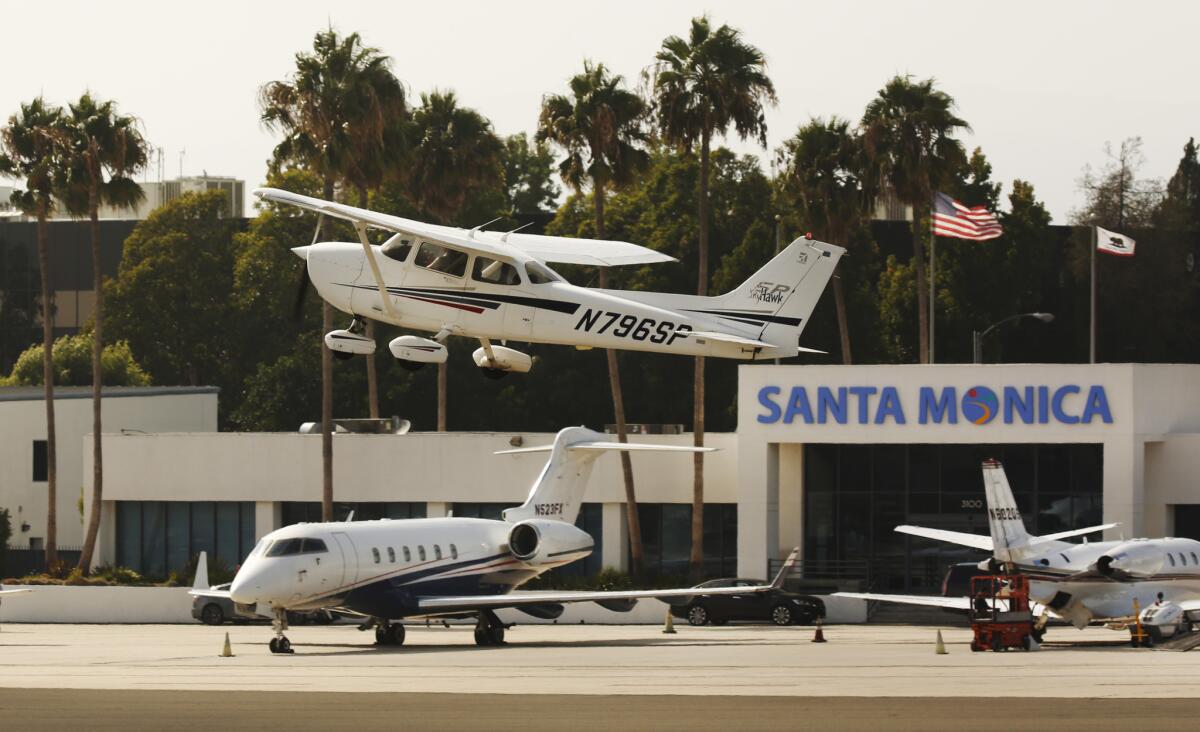FAA will investigate Santa Monica’s ‘starvation strategy’ to shut down its municipal airport

- Share via
The Federal Aviation Administration announced Tuesday that it would investigate Santa Monica’s so-called starvation strategy that could close the city’s embattled airport within two years.
It also issued a sharply worded warning for the city to put the brakes on the pending eviction of two airport businesses, a move some see as the first steps in Santa Monica’s plan.
Santa Monica officials have told Atlantic Aviation and American Flyers, two major tenants that provide a variety of aircraft services, to leave by Oct. 15.
“The FAA strongly recommends that the city withdraw the notices to vacate until such a time as this matter can be resolved,” the agency said.
FAA officials said they also plan to scrutinize the city’s airport leasing policy, a proposal to limit fuel sales and efforts to reduce jet operations until federal courts rule on whether the airport can be shut down, .
“These actions may be causing, and appear intended to cause, impairment of the airport, including, but not limited to, a ‘de facto’ closure of the airport in violation of applicable law,” the agency said in a notification to the city.
The FAA has given the city 10 days to respond to a federal subpoena for documents and information related to its airport policies.
“This is an overreach by the FAA,” Santa Monica Mayor Tony Vazquez said. “Our priority is putting the community first and exercising our rights as owner and operator of the airport. Now the FAA is clearly on a fishing expedition to protect Washington special interests who fear losing corporate profits.”
Once used by Douglas Aircraft Co., the 227-acre airport is now home to about 270 aircraft, from small Cessna propeller planes to large Gulfstream business jets. The facility serves as a reliever airport for Los Angeles International Airport and handles an average of 452 takeoffs and landings daily.
The FAA is clearly on a fishing expedition to protect Washington special interests who fear losing corporate profits.
— Tony Vazquez, Santa Monica Mayor
City officials and anti-airport activists say they want to close the facility because of noise, potentially harmful air pollution and the risk that an aircraft, particularly a large corporate jet, could crash into nearby neighborhoods.
Airport supporters assert that the facility is an important transportation asset and provides an estimated 1,500 jobs as well as $247 million in economic benefits to the community. Based on accident rates, they say, the airport is safer than other comparable airports in Southern California.
The FAA said it would look into the airport’s leasing policy that has resulted in the city entering leases with non-aeronautical activities while denying them to aviation uses.
Another target is a recent City Council decision to shut down the airport no later than July 1, 2018, if legally permitted. The city has sued in federal court in an attempt to overturn FAA requirements to keep the facility open.
We welcome the FAA’s investigation of the city’s management of the airport.
— Dave Hopkins, vice president of the Santa Monica Airport Assn.,
Atlantic Aviation and American Flyers, which were refused new leases, provide a range of aviation services, including aircraft storage, flight training, maintenance, facilities for charter flights and the sale of conventional fuels for jets and propeller planes.
The city wants to replace them with an exclusive city-run operation that would sell unleaded aviation gas and biofuel instead of standard jet fuel and leaded gas.
The FAA contends that the city’s actions might violate various federal agreements that require the airport to remain open and made available to the public “on reasonable terms” and “without unjust discrimination” to all types of aircraft and aeronautical activities.
Rules related to the acceptance of federal airport improvement grants require the airport to remain in operation at least until 2023.
When the airport was transferred back to Santa Monica in 1948 after its use by the U.S. military during World War II, the city agreed to keep it open in perpetuity or its operation could revert back to the federal government.
Santa Monica officials say that as the airport’s proprietor and operator, the city has a legal right to protect the health, safety and welfare of the environment and local residents. Any contractual agreements with the federal government, the city contends, do not nullify that right.
City officials also contend that FAA regulations give the them the power to create exclusive city-run aviation businesses and to evict tenants.
FAA officials declined to comment on the investigation or their options if violations are found.
In an earlier warning letter, a top ranking agency official told the city that “the FAA is prepared to pursue all legal remedies at its disposal if the City Council takes concrete actions to restrict leases or operations without complying with applicable federal law.”
Aviation attorneys said the FAA could issue an agency order stopping the evictions and prohibiting the city from implementing its closure policies. Such an order could be enforced in federal court, they said.
“We welcome the FAA’s investigation of the city’s management of the airport,” said Dave Hopkins, vice president of the Santa Monica Airport Assn., which is fighting to keep the airport open. He noted that there have been four federal complaints against the city “alleging a common theme of mismanagement and the misappropriation of airport funds.”
Three of the complaints, brought by airport tenants and national aviation organizations, are pending before the FAA. In the fourth, the FAA ruled that the airport must remain open at least until 2023. The city has appealed the ruling in federal court.
More to Read
Sign up for Essential California
The most important California stories and recommendations in your inbox every morning.
You may occasionally receive promotional content from the Los Angeles Times.











